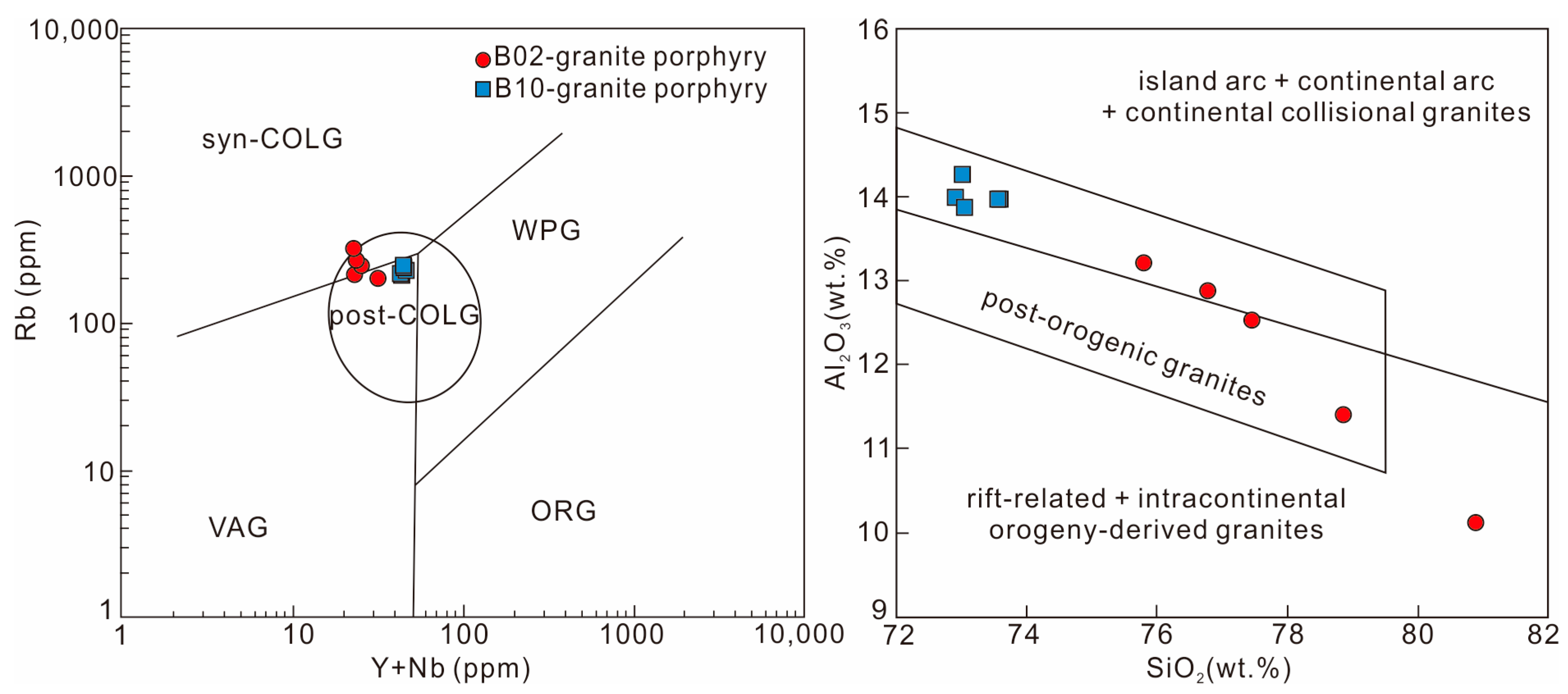Genesis and Tectonic Implications of Early Cretaceous Granites in the Haobugao Area, Southern Great Xing’an Range: Insights from Zircon U–Pb Geochronology, Hf Isotopic Composition, and Petrochemistry
Abstract
1. Introduction
2. Geological Setting
3. Materials and Methods
3.1. Field and Petrographical Investigation
3.2. Analytical Methods
4. Results
4.1. Petrography
4.2. Zircon U–Pb Dating
4.3. Major and Trace Element Compositions
4.4. Zircon Hf Isotopes
5. Discussions
5.1. Diagenetic and Metallogenic Epochs and Magmatic Evolution
5.2. Origin and Development of Volcanic Rocks
5.3. Tectonic Implications
6. Conclusions
Supplementary Materials
Author Contributions
Funding
Data Availability Statement
Acknowledgments
Conflicts of Interest
References
- Chappell, B.W.; White, A.J.R. Tow contrasting granite types. Russ. J. Pac. Geol. 1974, 8, 173–174. [Google Scholar]
- Collins, W.J.; Beams, S.D.; White, A.J.R.; Chappell, B.W. Nature and origin of A–type granites with particular reference to southeastern Australia. Contrib. Mineral. Petr. 1982, 80, 189–200. [Google Scholar] [CrossRef]
- Pitcher, W.S. Granite type and tectonic environment. In Mountain Building Processes; Hsu, K., Ed.; Academic Press: London, UK, 1983; pp. 19–40. [Google Scholar]
- White, A.J.R.; Chappell, B.W. Granitoid types and their distribution in the Lachlan Fold Belt, southeastern Australia. Geol. Soc. Am. Bull. 1983, 159, 21–34. [Google Scholar]
- Whalen, J.B. Geochemistry of an island-arc plutonic suite: The Uasilau–Yau Yau intrusive complex, New Britain, PNG. J. Petrol. 1985, 26, 603–632. [Google Scholar] [CrossRef]
- Whalen, J.B.; Currie, K.L.; Chappell, B.W. A–type granites: Geochemical characteristics, discrimination and petrogenesis. Contrib. Mineral. Petr. 1987, 95, 407–419. [Google Scholar] [CrossRef]
- Yang, J.H.; Wu, F.Y.; Chung, S.L.; Wilde, S.A.; Chu, M.F. A hybrid origin for the Qianshan A–type granite, northeast China: Geochemical and Sr–Nd–Hf isotopic evidence. Lithos 2006, 89, 89–106. [Google Scholar] [CrossRef]
- Jahn, B.M.; Wu, F.Y.; Chen, B. Massive granitoid generation in Central Asia: Nd isotopic evidence and implication for continental growth in the Phanerozoic. Episodes 2000, 23, 82–92. [Google Scholar] [CrossRef]
- Jahn, B.M. The central asian orogenic belt and growth of the continental crust in the Phanerozoic. Geological Society of London Special Publication: London, UK, 2004; Volume 226, pp. 73–100. [Google Scholar] [CrossRef]
- Wu, F.Y.; Liu, X.C.; Ji, W.Q.; Wang, J.M.; Yang, L. Highly fractionated granites: Recognition and research. Sci. China Earth Sci. 2017, 60, 1201–1219. [Google Scholar] [CrossRef]
- Ishihara, S. The granitoid series and mineralization. In Economic Geology Publishing Company Seventy—Fifth Anniversary Volume; Skinner, B.J., Ed.; Society of Economic Geologists: London, UK, 1981; pp. 458–484. [Google Scholar]
- Lehmann, B. Metallogeny of Tin; Springer: Berlin, Germany, 1990; pp. 1–210. [Google Scholar]
- Chappell, B.W.; White, A.J.R. I–and S–type granites in the Lachlan Fold Belt. Earth Environ. Sci. Trans. R. Soc. Edinb. 1992, 83, 1–26. [Google Scholar]
- Collins, W.J. Evaluation of petrogenetic models for Lachlan Fold Belt granitoids: Implications for crustal architecture and tectonic models. Aust. J. Earth Sci. 1998, 45, 483–500. [Google Scholar] [CrossRef]
- Rudnick, R.L.; Fountain, D.M. Nature and composition of the continental crust: A lower crustal perspective. Rev. Geophys. 1995, 33, 267–309. [Google Scholar] [CrossRef]
- Annen, C.; Spades, R.S.J. Effects of repetidve emplacement of basaltic intrusions on thermal evolution and melt generation in the crust. Earth Planet. Sci. Lett. 2002, 203, 937–955. [Google Scholar] [CrossRef]
- Sengör, A.M.C.; Natal’in, B.A.; Burtman, V.S. Evolution of the Altaid tectonic collage and Palaeozoic crustal growth in Eurasia. Nature 1993, 364, 299–307. [Google Scholar] [CrossRef]
- Windley, B.F.; Alexeiev, D.; Xiao, W.J.; Kröner, A.; Badarch, G. Tectonic models for accretion of the central Asian orogenic belt. J. Geol. Soc. 2007, 164, 31–47. [Google Scholar] [CrossRef]
- Ouyang, H.G.; Mao, J.W.; Zhou, Z.H.; Su, H.M. Late Mesozoic metallogeny and intracontinental magmatism, southern Great Xing’an Range, northeastern China. Gondw. Res. 2015, 27, 1153–1172. [Google Scholar] [CrossRef]
- Li, J.Y.; Mo, S.G.; He, Z.J.; Sun, G.H.; Chen, W. The timing of crustal strike–slip movement in the northern Great Khing’an ranges and its constraint on reconstruction of the crustal tectonic evolution of NE China and adjacent areas since the Mesozoic. Earth Sci. Front. 2004, 11, 157–168, (In Chinese with English Abstract). [Google Scholar]
- Zhang, D.Q.; Zhao, Y.M. Collection of Papers on Copper Polymetallic Deposits in Great Xing’an Range and Adjacent Areas; Geology Press: Beijing, China, 1994; pp. 1–161. (In Chinese) [Google Scholar]
- Yang, S.S.; Wang, H.; Zhu, X.Y.; Zou, T.; Yang, C.L.; Jiang, H.Y.; Jiang, B.B.; Cheng, X.Y.; Li, Y.J. The metallogenic mechanism of skarn Sn–polymetallic deposits in the Southern Great Khingan Range, China: Constraints on the geological and geochemical characteristics of Damogutu Sn–Fe and Dashishan Sn–Pb–Zn Deposits. Minerals 2019, 9, 418. [Google Scholar] [CrossRef]
- Tang, W.H.; Li, J.; Wang, K.Y.; Li, S.D.; Cai, W.Y.; Liu, H.L.; Wang, Y.C. Ore genesis and tectonic setting of the Laojiagou porphyry molybdenum deposit, Inner Mongolia, China: Evidence from geology, fluid inclusions, H–O isotopes, zircon U–Pb geochronology, and geochemistry. Arab. J. Geosci. 2019, 12, 731. [Google Scholar] [CrossRef]
- Liu, L.J.; Zhou, T.F.; Zhang, D.Y.; Liu, G.X.; Zhao, Z.C.; Sun, J.D.; White, N.C. Major and trace elements analyses of garnet from the Haobugao Zn–Fe–Sn polymetallic deposit, northeast China: Implications for skarn formation and hydrothermal fluid evolution. Ore Geol. Rev. 2021, 138, 104337. [Google Scholar] [CrossRef]
- Niu, X.D.; Shu, Q.H.; Xing, K.; Yuan, S.R.; Wei, L.M.; Zhang, Y.P.; Yu, F.; Zeng, Q.W.; Ma, S.L. Evaluating Sn mineralization potential at the Haobugao skarn Zn–Pb deposit (NE China) using whole–rock and zircon geochemistry. J. Geochem. Explor. 2022, 234, 106938. [Google Scholar] [CrossRef]
- Mi, K.F.; Lü, Z.C.; Liu, Q.; Yan, T.J.; Wang, L.M.; Li, Y.S. Zircon U–Pb ages and geochemical characteristics of granites in the Yaoertu deposit: Implications for Pb–Zn–Ag mineralization in the southern Great Xing’an Range, NE China. Ore Geol. Rev. 2021, 134, 104160. [Google Scholar] [CrossRef]
- Liu, J.M.; Ye, J.; Li, Y.B.; Chen, X.S.; Zhang, R.B. A preliminary study on exhalative mineralization in Permian Basins, the southern segment of the Da Hinggan Mountains, China–case studies of the Huanggang and Dajing deposits. Resour. Geol. 2001, 51, 345–358. [Google Scholar] [CrossRef]
- Chen, Z.C.; Zhang, L.C.; Wan, B.; Wu, H.Y.; Cleven, N. Geochronology and geochemistry of the Wunugetushan porphyry Cu–Mo deposit in NE China, and their geological significance. Ore Geol. Rev. 2011, 43, 92–105. [Google Scholar] [CrossRef]
- Jiang, S.H.; Chen, C.L.; Bagas, L.; Liu, Y.; Han, N.; Kang, H.; Wang, Z.H. Two mineralization events in the Baiyinnuoer Zn–Pb deposit in Inner Mongolia, China: Evidence from field observations, S–Pb isotopic compositions and U–Pb zircon ages. J. Asian Earth Sci. 2017, 144, 339–367. [Google Scholar] [CrossRef]
- Liu, L.J.; Zhou, T.F.; Zhang, D.Y.; Yuan, F.; Liu, G.X.; Zhao, Z.C.; Sun, J.D.; White, N. S isotopic geochemistry, zircon and cassiterite U–Pb geochronology of the Haobugao Sn polymetallic deposit, southern Great Xing’an Range, NE China. Ore Geol. Rev. 2018, 93, 168–180. [Google Scholar] [CrossRef]
- Yang, F.; Wu, G.; Chen, G.Z.; Zhang, T.; Li, Y.L.; Li, S.H.; Shi, J.P. Mineralization of the Weilasituo rare metal–tin–polymetallic ore deposit in Inner Mongolia: Insights from fractional crystallization of granitic magmas. Miner. Depos. 2023, 37, 637–664, (In Chinese with English Abstract). [Google Scholar]
- Wang, W.; Tang, J.; Xu, W.L.; Wang, F. Geochronology and geochemistry of Early Jurassic volcanic rocks in the Erguna Massif, northeast China: Petrogenesis and implications for the tectonic evolution of the Mongol–Okhotsk suture belt. Lithos 2015, 218–219, 73–86. [Google Scholar] [CrossRef]
- Li, S.; Chung, S.L.; Wang, T.; Wilde, S.A.; Chu, M.F.; Guo, Q.Q. Tectonic significance and geodynamic processes of large–scale Early Cretaceous granitoid magmatic events in the southern Great Xing’an Range, North China. Tectonics 2017, 36, 615–633. [Google Scholar] [CrossRef]
- Liu, R.; Yang, Z.; Xu, Q.D.; Zhang, X.J.; Yao, C.L. Zircon U–Pb ages, elemental and Sr–Nd–Pb isotopic geochemistry of the Hercynian granitoids from the southern segment of the Da Hinggan Mts.: Petrogenesis and tectonic implications. Acta Petrol. Sin. 2016, 32, 1505–1528, (In Chinese with English Abstract). [Google Scholar]
- Dong, Y.; Ge, W.C.; Tian, D.X.; Ji, Z.; Yang, H.; Bi, J.H.; Wu, H.R.; Hao, Y.J. Geochronology and geochemistry of Early Cretaceous granitic plutons in the Xing’an Massif, Great Xing’an Range, NE China: Petrogenesis and Tectonic Implications. Acta Geol. Sin. Engl. Ed. 2019, 93, 1500–1521. [Google Scholar] [CrossRef]
- Hu, T.; Sun, Z.J.; Liu, G.H.; Yu, H.N.; Wang, C.Y.; Zhao, Z.C.; Sun, J.D. Zircon U–Pb dating, Lu–Hf isotopic composition and geological significance of granites in the Haobugao Pb–Zn deposit, southern Great Xing’an Range, China. Arab. J. Geosci. 2020, 13, 1047. [Google Scholar] [CrossRef]
- Wei, W.; Zou, T.; Huang, X.K.; Binbin Jiang, B.B.; Zhu, X.Y.; Wu, X.Y. Petrogenesis of early Cretaceous granitoids in the southern Great Xing’an Range, NE China: Constraints from the Haliheiba pluton. Geochemistry 2020, 80, 125608. [Google Scholar] [CrossRef]
- Ran, X.J.; Wang, X.; Sun, Z.M. Petrogenesis and tectonic setting of Early Cretaceous A–type granite from the southern Great Xing’an Range, northeastern China: Geochronological, geochemical, and Hf isotopic evidence. Minerals 2023, 13, 1523. [Google Scholar] [CrossRef]
- Zhou, Z.H.; Mao, J.W.; Lyckberg, P. Geochronology and isotopic geochemistry of the A–type granites from the Huanggang Sn–Fe deposit, southern Great Hinggan Range, NE China: Implication for their origin and tectonic setting. J. Asian Earth Sci. 2012, 49, 272–286. [Google Scholar] [CrossRef]
- Li, J.F.; Wang, K.Y.; Quan, H.Y.; Sun, F.Y.; Zhao, L.S.; Zhang, X.B. Discussion on the magmatic evolution sequence and metallogenic geodynamical setting background Hongling Pb–Zn deposit in the southern Da Xing’an Mountains. Acta Petrol. Sin. 2016, 32, 1529–1542, (In Chinese with English Abstract). [Google Scholar]
- Fan, W.M.; Guo, F.; Wang, Y.J.; Lin, G. Late Mesozoic calc–alkaline volcanism of post–orogenic extension in the northern Da Hinggan Mountains, northeastern China. J. Volcanol. Geotherm. Res. 2003, 121, 115–135. [Google Scholar] [CrossRef]
- Wu, F.Y.; Lin, J.Q.; Wilde, S.A.; Zhang, X.O.; Yang, J.H. Nature and significance of the Early Cretaceous giant igneous event in eastern China. Earth Planet. Sci. Lett. 2005, 233, 103–119. [Google Scholar] [CrossRef]
- Guo, F.; Fan, W.M.; Gao, X.F.; Li, C.W.; Miao, L.C.; Zhao, L.A.; Li, H.X. Sr–Nd–Pb isotope mapping of Mesozoic igneous rocks in NE China constraints on tectonic framework and Phanerozoic crustal growth. Lithos 2010, 120, 563–578. [Google Scholar] [CrossRef]
- Wilde, S.A. Final amalgamation of the Central Asian orogenic belt in NE China: Paleo-Asian Ocean closure versus Paleo-Pacific plate subduction—A review of the evidence. Tectonophysics 2015, 662, 345–362. [Google Scholar] [CrossRef]
- Tang, J.; Xu, W.L.; Wang, F.; Zhao, S.; Li, Y. Geochronology, geochemistry, and deformation history of Late Jurassic–Early Cretaceous intrusive rocks in the Erguna Massif, NE China: Constraints on the late Mesozoic tectonic evolution of the Mongol–Okhotsk orogenic belt. Tectonophysics 2015, 658, 91–110. [Google Scholar] [CrossRef]
- Jahn, B.M.; Litvinovsky, B.A.; Zanvilevich, A.N.; Reichow, M. Peralkaline granitoid magmatism in the Mongolian-Transbaikalian Belt: Evolution, petrogenesis and tectonic significance. Lithos 2009, 113, 521–539. [Google Scholar] [CrossRef]
- Han, S.J.; Wang, X.; Wang, X.; Wang, Y.; Zhang, Y. Geochronology and geochemistry of late Jurassic–Early Cretaceous volcanic rocks in the southern Great Xing’an range, NE China: Constraints for late Mesozoic tectono-magmatic evolution. Int. Geol. Rev. 2021, 63, 1366–1388. [Google Scholar] [CrossRef]
- Zhang, J.H.; Gao, S.; Ge, W.C.; Wu, F.Y.; Yang, J.H.; Wilde, S.A.; Li, M. Geochronology of the Mesozoic volcanic rocks in the Great Xing’an Range, northeastern China: Implications for subduction-induced delamination. Chem. Geol. 2010, 276, 144–165. [Google Scholar] [CrossRef]
- Wu, F.Y.; Sun, D.Y.; Ge, W.C.; Zhang, Y.B.; Grant, M.L.; Wilde, S.A.; Jahn, B.-M. Geochronology of the Phanerozoic granitoids in northeastern China. J. Asian. Earth Sci. 2011, 41, 1–30. [Google Scholar] [CrossRef]
- Tang, Z.Y.; Li, J.; Li, Q.Y.; Sun, D.Y.; Gou, J.; Deng, C.Z. Spatio– and temporal patterns of Jurassic–Early Cretaceous volcanism in the Great Xing’an range, NE China: Constraints on the geodynamic evolution. Int. Geol. Rev. 2023, 65, 1977–1998. [Google Scholar] [CrossRef]
- Liu, Y.S.; Gao, S.; Hu, Z.C.; Gao, C.G.; Zong, K.Q.; Wang, D.B. Continental and oceanic crust recycling–induced melt–peridotite interactions in the Trans–North China Orogen: U–Pb dating, Hf isotopic and trace elements in zircons from mantle xenoliths. J. Petrol. 2010, 51, 537–571. [Google Scholar] [CrossRef]
- Sláma, J.; Košler, J.; Condon, D.J.; Crowley, J.L.; Gerdes, A.; Hanchar, J.M.; Horstwood, M.S.A.; Morris, G.A.; Nasdala, L.; Norberg, N.; et al. Plešovice zircon-a new natural reference material for U–Pb and Hf isotopic microanalysis. Chem. Geol. 2008, 249, 1–35. [Google Scholar] [CrossRef]
- Wiedenbeck, M.; Allé, P.; Corfu, F.; Griffin, W.L.; Meier, M.; Oberli, F.; von Quadt, A.; Roddick, J.C.; Spiegel, W. Three natural zircon standards for U–Th–Pb, Lu–Hf, trace element and REE analyses. Geostand. Newsl. 1995, 19, 1–23. [Google Scholar] [CrossRef]
- Cai, P.R.; Wang, T.; Wang, Z.Q.; Li, L.M.; Jia, J.L.; Wang, M.Q. Geochronology and geochemistry of late Paleozoic volcanic rocks from eastern Inner Mongolia, NE China: Implications for igneous petrogenesis, tectonic setting, and geodynamic evolution of the south-eastern Central Asian Orogenic Belt. Lithos 2020, 362–363, 105480. [Google Scholar] [CrossRef]
- Ludwig, K.R. Isoplot v. 4.15: A Geochronological Toolkit for Microsoft Excel; Berkeley Geochronology Center Special Publication: Berkeley, CA, USA, 2011; Volume 4, p. 75. [Google Scholar]
- Wu, F.Y.; Yang, Y.H.; Xie, L.W.; Yang, J.H.; Xu, P. Hf isotopic compositions of the standard zircons and baddeleyites used in U–Pb geochronology. Chem. Geol. 2006, 234, 105–126. [Google Scholar] [CrossRef]
- Vervoort, J.D.; Blichert-Toft, J. Evolution of the depleted mantle: Hf isotope evidence from juvenile rocks through time. Geochim. Cosmochim. Acta 1999, 63, 533–556. [Google Scholar] [CrossRef]
- Griffin, W.L.; Wang, X.; Jackson, S.E.; Pearson, N.J.; O’Reilly, S.Y.; Xu, X.S.; Zhou, X.M. Zircon chemistry and magma mixing, SE China: In-situ analysis of Hf isotopes, Tonglu and Pingtan igneous complexes. Lithos 2002, 61, 237–269. [Google Scholar] [CrossRef]
- Pupin, J.P. Zircon and granite petrology. Contrib. Mineral. Petrol. 1980, 73, 207–220. [Google Scholar] [CrossRef]
- Hanchar, J.M.; Miller, C.F. Zircon zonation patterns as revealed by cathodoluminescence and backscattered electron images: Implications for interpretation of complex crustal histories. Chem. Geol. 1993, 110, 1–13. [Google Scholar] [CrossRef]
- Corfu, F.; Hanchar, J.M.; Hoskin, P.W.; Kinny, P. Atlas of zircon textures. Rev. Miner. Geochem. 2003, 53, 469–495. [Google Scholar] [CrossRef]
- Hoskin, P.W.O.; Schaltegger, U. The composition of zircon and igneous and metamorphic petrogenesis. Rev. Miner. Geochem. 2003, 53, 27–62. [Google Scholar] [CrossRef]
- Lee, J.K.W.; Williams, I.S.; Ellis, D. Pb, U and Th diffusion in natural zircon. Nature 1997, 390, 159–163. [Google Scholar] [CrossRef]
- Cherniak, D.J.; Watson, E.B. Pb diffusion in zircon. Chem. Geol. 2000, 172, 5–24. [Google Scholar] [CrossRef]
- Le Maitre, R.W. Igneous Rocks: A Classification and Glossary of Terms; Cambridge University Press: Cambridge, UK, 2002; pp. 1–236. [Google Scholar]
- Peccerillo, A.; Taylor, S.R. Geochemistry of Eocene calc–alkaline volcanic rocks from the Kastamonu area, northern Turkey. Contrib. Mineral. Petr. 1976, 58, 63–81. [Google Scholar] [CrossRef]
- Maniar, P.D.; Piccoli, P.M. Tectonic discrimination of granitoids. Geol. Soc. Am. Bull. 1989, 101, 635–643. [Google Scholar] [CrossRef]
- Sun, S.S.; McDonough, W.F. Chemical and isotopic systematics of oceanic basalts: Implications for mantle composition and processes. In Magmatism in Ocean Basins; Saunders, A.D., Norry, M.J., Eds.; Geological Society of London Special Publication: London, UK, 1989; pp. 313–345. [Google Scholar]
- Taylor, S.R.; Mclennan, S.M. The continental crust: Its composition and evolution. J. Geol. 1985, 94, 57–72. [Google Scholar]
- Yang, J.H.; Wu, F.Y.; Wilde, S.A.; Xie, L.W.; Yang, Y.H.; Liu, X.M. Tracing magma mixing in granite genesis: In situ U–Pb dating and Hf-isotope analysis of zircons. Contrib. Mineral. Petrol. 2007, 153, 177–190. [Google Scholar] [CrossRef]
- Zhou, Z.H.; Lü, L.S.; Yang, Y.J.; Li, T. Petrogenesis of the Early Cretaceous A–type granite in the Huanggang Sn–Fe deposit, inner Mongolia: Constraints from zircon U–Pb dating and geochemistry. Acta Petrol. Sin. 2010, 26, 3521–3537, (In Chinese with English Abstract). [Google Scholar]
- Wan, D.; Li, J.F.; Wang, Y.C.; Wang, K.Y.; Wang, Z.G.; Wei, L.M. Re–Os Radiometric dating of molybdenite in Hongling lead–zinc polymetallic deposit, Inner Mongolia, and its significance. Earth Sci. J. China Univ. Geosci. 2014, 39, 687–695, (In Chinese with English Abstract). [Google Scholar]
- Hu, T. Paleozoic–Mesozoic Granitic Magmatism and Its Tectonic Implication, Haobugao Area, Southern Great Xing’an Range. Master’s Thesis, Institute of Disaster Prevention, Langfang, China, 2022. (In Chinese with English Abstract). [Google Scholar]
- Feng, X.L.; Cheng, Z.G.; Liu, Z.; Zhang, Y. Metallogenic age of the Caojiatun Mo deposit in the southern Great Xing’an Range: Evidence from molybdenite Re—Os isotopic dating. Geol. China 2022, 49, 667–668. (In Chinese) [Google Scholar]
- Zhou, Z.H.; Li, B.Y.; Wang, A.S.; Wu, X.L.; Ouyang, H.G.; Feng, J.R. Zircon SHRIMP U–Pb dating and geochemical characteristics of late variscan granites of the Daitongshan copper deposit and lamahanshan polymetallic–silver deposit, southern Daxing’anling, China. J. Earth Sci. 2013, 24, 772–795. [Google Scholar] [CrossRef]
- Zhang, D.Q.; Bao, X.W. A study on the petrology, geochemistry and genesis of the Bayan Nur intermediate–acidic volcano–plutonic complex in Eastern Inner Mongolia. Geol. Rev. 1990, 36, 289–297, (In Chinese with English Abstract). [Google Scholar]
- Wang, J.F.; Li, Y.J.; Li, H.Y.; Dong, P.P. Zircon U–Pb dating of the Shijiangshan Late Jurassic–Early Cretaceous A–type granite in Xi Ujimqin Banner of Inner Mongolia and its tectonic setting. Geol. Bull. China 2018, 37, 382–396, (In Chinese with English Abstract). [Google Scholar]
- Ouyang, H.G.; Li, R.H.; Zhou, Z.H. The Jurassic mineralization of the Shuangjianzishan Ag–polymetallic deposit and its significance in prospecting: Evidence from geochronology. Acta Geol. Sin. 2016, 90, 1835–1845, (In Chinese with English Abstract). [Google Scholar]
- Zhou, T.; Sun, Z.J.; Yu, H.N.; Wang, C.Y.; Liu, G.H. Zircon U–Pb geochronology, Hf isotope and whole–rock geochemical characteristics of Xiaohanshan pluton in Haobugao Pb–Zn Deposit, Inner Mongolia. Geoscience 2022, 36, 282–294, (In Chinese with English Abstract). [Google Scholar]
- Yang, Q.D.; Guo, L.; Wang, T.; Zeng, T.; Zhang, L.; Tong, Y.; Shi, X.J.; Zhang, J.J. Geochronology, origin, sources and tectonic settings of Late Mesozoic two–stage granites in the Ganzhuermiao region, central and southern Da Hinggan Range, NE China. Acta Petrol. Sin. 2014, 30, 1961–1981, (In Chinese with English Abstract). [Google Scholar]
- Yuan, S.R. Geochemistry of the Granite from the Haobugao Skarn Zn–Pb Deposit in Inner Mongolia, and Its Geological Significance. Master’s Thesis, China University of Geoscience, Beijing, China, 2020. (In Chinese with English Abstract). [Google Scholar]
- Zhou, Z.H.; Lü, L.S.; Wang, A.S. Deep source characteristics and tectonic–magmatic evolution of granite in the Huanggang Sn–Fe deposit, Inner Mongolia: Constrain from Sr–Nd–Pb–Hf multiple isotopes. Geol. Sci. Technol. Inf. 2011, 30, 1–14, (In Chinese with English Abstract). [Google Scholar]
- Loiselle, M.C.; Wones, D.R. Characteristics and Origin of Anorogenic Granites; Geological Society America Abstract with Programs: Boulder, CO, USA, 1979; pp. 1–468. [Google Scholar]
- Eby, G.N. The A–type granitoids: A review of their occurrence and chemical characteristics and speculations on their petrogenesis. Lithos 1990, 26, 115–134. [Google Scholar] [CrossRef]
- Frost, C.D.; Frost, B.R. On ferroan (A-type) granitoids: Their compositional variability and modes of origin. J. Petrol. 2011, 52, 39–53. [Google Scholar] [CrossRef]
- Anderson, J.L.; Bender, E.E. Nature and origin of Proterozoic A-type granitic magmatism in the southwestern United States of America. Lithos 1989, 23, 19–52. [Google Scholar] [CrossRef]
- Eby, G.N. Chemical subdivision of the A–type granitoids: Petrogenetic and tectonic implications. Geology 1992, 20, 641–644. [Google Scholar] [CrossRef]
- Breiter, K.; Lamarão, C.N.; Borges, R.M.K.; Dall’Agnol, R. Chemical characteristics of zircon from A–type granites and comparison to zircon of S–type granites. Lithos 2014, 192–195, 208–225. [Google Scholar] [CrossRef]
- King, P.L.; Chappell, B.W.; Allen, C.M.; White, A.J.R. Are A-type granites the high-temperature felsic granites? Evidence from fractionated granites of the Wangrah Suite. Aust. J. Earth Sci. 2001, 48, 501–514. [Google Scholar] [CrossRef]
- Clemens, J.D.; Stevens, G. What controls chemical variation in granitic magmas? Lithos 2012, 134, 317–329. [Google Scholar] [CrossRef]
- Clemens, J.D. S-type granitic magmas—Petrogenetic issues, models and evidence. Earth Sci. Rev. 2003, 61, 1–18. [Google Scholar] [CrossRef]
- Watson, E.B.; Harrison, T.M. Zircon saturation revisited: Temperature and composition effects in a variety of crustal magma types. Earth Planet. Sci. Lett. 1983, 64, 295–304. [Google Scholar] [CrossRef]
- Bonin, B. A-type granites and related rocks: Evolution of a concept, problems and prospects. Lithos 2007, 97, 1–29. [Google Scholar] [CrossRef]
- Dickin, A.P.; Halliday, A.N.; Bowden, P. A Pb, Sr, and Nd isotope study of the basement and Mesozoic ring complexes of the Jos Plateau, Nigeria. Chem. Geol. 1991, 94, 23–32. [Google Scholar] [CrossRef]
- Creaser, R.A.; Price, R.C.; Wormald, R.J. A-type granites revisited: Assessment of a residual-source model. Geology 1991, 19, 163–166. [Google Scholar] [CrossRef]
- Landenberger, B.; Collins, W.J. Derivation of A-type granites from a dehydrated charnockitic lower crust: Evidence from the Chaelundi complex. East. Aust. J. Petrol. 1996, 37, 145–170. [Google Scholar] [CrossRef]
- Douce, A.E.P. Generation of metaluminous A–type granites by low–pressure melting of calc–alkaline granitoids. Geology 1997, 25, 743–746. [Google Scholar] [CrossRef]
- Pearce, J.A. The role of sub-continental lithosphere in magma genesis at destructive plate margins. Cont. Basalts Mantle Xenoliths 1983, 147, 2162–2173. [Google Scholar]
- Mushkin, A.; Navon, O.; Halicz, L.; Hartmann, G.; Stein, M. The petrogenesis of A-type magmas from the Amram Massif, southern Israel. J. Petrol. 2003, 44, 815–832. [Google Scholar] [CrossRef]
- Meinert, L.D. Compositional Variation of Igneous Rocks Associated with Skarn Deposits–Chemical Evidence for A Genetic Connection Between Petrogenesis and Mineralization; Short Course Series Volume; Mineralogical Association of Canada: Couronne, QC, Canada, 1995; pp. 401–418. [Google Scholar]
- Sato, K.; Vrublevsky, A.A.; Rodionov, S.M.; Romanovsky, N.P.; Nedachi, M. Mid–cretaceous episodic Magmatism and tin mineralization in Khingan–Okhotsk volcano–plutonic belt, Far East Russia. Resour. Geol. 2002, 52, 1–14. [Google Scholar] [CrossRef]
- Meinert, L.D.; Dipple, G.M.; Nicolescu, S. World skarn deposits. In 100th Anniversary Volume; Society of Economic Geologists: Littleton, CO, USA, 2005; pp. 299–336. [Google Scholar]
- Mao, J.W.; Cheng, Y.B.; Chen, M.H.; Pirajno, F. Major types and time–space distribution of Mesozoic ore deposits in South China and their geodynamic settings. Miner. Deposita 2013, 48, 267–294. [Google Scholar]
- Wang, R.C.; Xie, L.; Chen, J.; Yu, A.P.; Wang, L.B.; Lu, J.J.; Zhu, J.C. Tin–carrier minerals in metaluminous granites of the western Nanling Range (southern China): Constraints on processes of tin mineralization in oxidized granites. J. Asian Earth Sci. 2013, 74, 361–372. [Google Scholar] [CrossRef]
- Romer, R.L.; Kroner, U. Phanerozoic tin and tungsten mineralization: Tectonic controls on the distribution of enriched protoliths and heat sources for crustal melting. Gondw. Res. 2016, 31, 60–95. [Google Scholar] [CrossRef]
- Chang, Z.; Shu, Q.; Meinert, L.D. Skarn deposits of China. In Mineral Deposits of China; Society of Economic Geologists, Special Publication: Littleton, CO, USA, 2019; pp. 189–234. [Google Scholar]
- Lehmann, B. Formation of tin ore deposits: A reassessment. Lithos 2020, 402–403, 105756. [Google Scholar] [CrossRef]
- Bastos Neto, A.C.; Pereira, V.P.; Ronchi, L.H.; de Lima, E.F.; Frantz, J.C. The world-class Sn, Nb, Ta, F (Y, REE, Li) deposit and the massive cryolite associated with the albite—enriched facies of the Madeira A-type granite, Pitinga mining district, Amazonas State, Brazil. Can. Mineral. 2009, 47, 1329–1357. [Google Scholar] [CrossRef]
- Chen, X.C.; Zhao, C.H.; Zhu, J.J.; Wang, X.S.; Cui, T. He, Ar, and S isotopic constraints on the relationship between A–type granites and tin mineralization: A case study of tin deposits in the Tengchong–Lianghe tin belt, Southwest China. Ore Geol. Rev. 2018, 92, 416–429. [Google Scholar] [CrossRef]
- Zhang, L.P.; Zhang, R.Q.; Hu, Y.B.; Liang, J.L.; Ouyang, Z.X.; He, J.J.; Chen, Y.X.; Guo, J.; Sun, W.D. The formation of the Late Cretaceous Xishan Sn–W deposit, South China: Geochronological and geochemical perspectives. Lithos 2017, 290–291, 253–268. [Google Scholar] [CrossRef]
- Zhang, L.P.; Zhang, R.Q.; Wu, K.; Chen, Y.X.; Li, C.Y.; Hu, Y.B.; He, J.J.; Liang, J.L.; Sun, W.D. Late Cretaceous granitic magmatism and mineralization in the Yingwuling W–Sn deposit, South China: Constraints from zircon and cassiterite U–Pb geochronology and whole–rock geochemistry. Ore Geol. Rev. 2018, 96, 115–129. [Google Scholar] [CrossRef]
- Liu, P.; Mao, J.W.; Santosh, M.; Bao, Z.A.; Zeng, X.J.; Jia, L.H. Geochronology and petrogenesis of the Early Cretaceous A–type granite from the Feie’shan W–Sn deposit in the eastern Guangdong Province, SE China: Implications for W–Sn mineralization and geodynamic setting. Lithos 2018, 300–301, 330–347. [Google Scholar] [CrossRef]
- Yan, Q.H.; Wang, H.; Qiu, Z.W.; Wei, X.P.; Li, P.; Dong, R.; Zhang, X.Y.; Zhou, K.L. Origin of Early Cretaceous A–type granite and related Sn mineralization in the Sanjiaowo deposit, eastern Guangdong, SE China and its tectonic implication. Ore Geol. Rev. 2018, 93, 60–80. [Google Scholar] [CrossRef]
- Scherer, E.E.; Cameron, K.L.; Blichert-Toft, J. Lu–Hf garnet geochronology: Closure temperature relative to the Sm–Nd system and the effects of trace mineral inclusions. Geochim. Cosmochim. Acta 2000, 64, 3413–3432. [Google Scholar] [CrossRef]
- Yuri, A.D.; Pidgeon, R.T. Nature of the earth’s earliest crust from hafnium isotopes in single detrital zircons. Nature 1999, 399, 252–255. [Google Scholar]
- Shu, Q.; Chang, Z.; Lai, Y.; Zhou, Y.; Sun, Y.; Yan, C. Regional metallogeny of Mo-bearing deposits in northeastern China, with new Re-Os dates of porphyry Mo deposits in the northern Xilamulun district. Econ. Geol. 2016, 111, 1783–1798. [Google Scholar] [CrossRef]
- Yu, Y.; Xu, W.L.; Pei, F.P.; Yang, D.B.; Zhao, Q.G. Chronology and geochemistry of Mesozoic volcanic rocks in the Linjiang area, Jilin Province and their tectonic implications. Acta Geol. Sin. 2009, 83, 245–257. [Google Scholar] [CrossRef]
- Xu, W.L.; Pei, F.P.; Wang, F.; Meng, E.; Ji, W.Q.; Yang, D.B.; Wang, W. Spatial–temporal relationships of Mesozoic volcanic rocks in NE China: Constraints on tectonic overprinting and transformations between multiple tectonic regimes. J. Asian Earth Sci. 2013, 74, 167–193. [Google Scholar] [CrossRef]
- Meng, Q.R. What drove late Mesozoic extension of the northern China–Mongolia tract? Tectonophysics 2003, 369, 155–174. [Google Scholar] [CrossRef]
- Pearce, J.A.; Harris, B.W.; Tindle, A.G. Trace element discrimination diagrams for the tectonic interpretation of granitic rocks. J. Petrol. 1984, 25, 956–983. [Google Scholar] [CrossRef]
- Dong, X.Z.; Zhou, Z.H.; Wang, R.H.; Li, J.W.; He, S. Geochronology and geochemistry of granite in Aobaotu Pb–Zn deposit, Inner Mongolia. Miner. Depos. 2014, 33, 323–338, (In Chinese with English Abstract). [Google Scholar]
- Peng, Q.S.; Zhang, Z.Q.; Zhu, X.Y.; Huang, X.K.; Xu, Q. U–Pb age of zircon mineral in Huaganzigou pluton and its geological significance in central and southern part pf the Da Hinggan Mountains. Miner. Explor. 2017, 8, 927–936, (In Chinese with English Abstract). [Google Scholar]
- Wang, X.D. Magmatism and Mineralization of Ag-Pb-Zn Polymetallic Deposits in the Lindong District, Inner Mongolia. Ph.D. Thesis, China University of Geosciences, Wuhan, China, 2017. (In Chinese with English Abstract). [Google Scholar]
- Zhu, P.P.; Cheng, Q.M.; Zhang, Z.J.; Wang, Z.Y. Genesis and implications of the Late Jurassic Hailesitai granites in the northern Greater Khingan Range: Evidence from zircon U−Pb dating and Hf isotope. Geol. Mag. 2017, 154, 963–982. [Google Scholar] [CrossRef]
- Li, J.F. Mineralization and Periphery Metallogenic Prediction of the Hongling Pb–Zn Polymetallic Deposit in Chifeng, Inner Mongolia. Ph.D. Thesis, Jilin University, Changchun, China, 2015. (In Chinese with English Abstract). [Google Scholar]
- Liu, F.; Wang, X.; Hai, L.F.; Zhao, D.S. Zircon U-Pb ages, Hf isotope and extensional tectonics of monzogranite in the Hansumu area of southern Great Khingan. Geol. China 2021, 48, 1609–1622, (In Chinese with English Abstract). [Google Scholar]
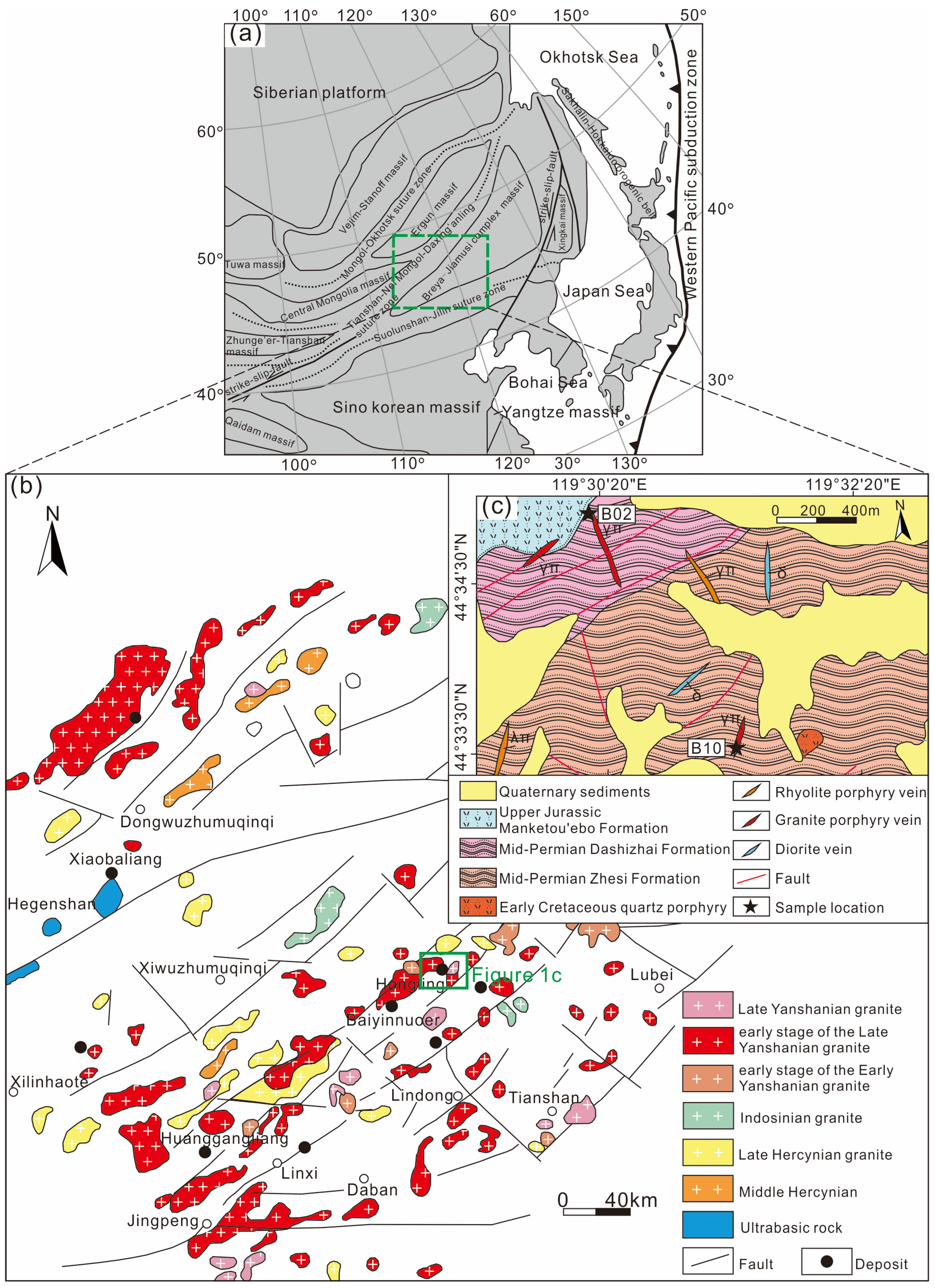
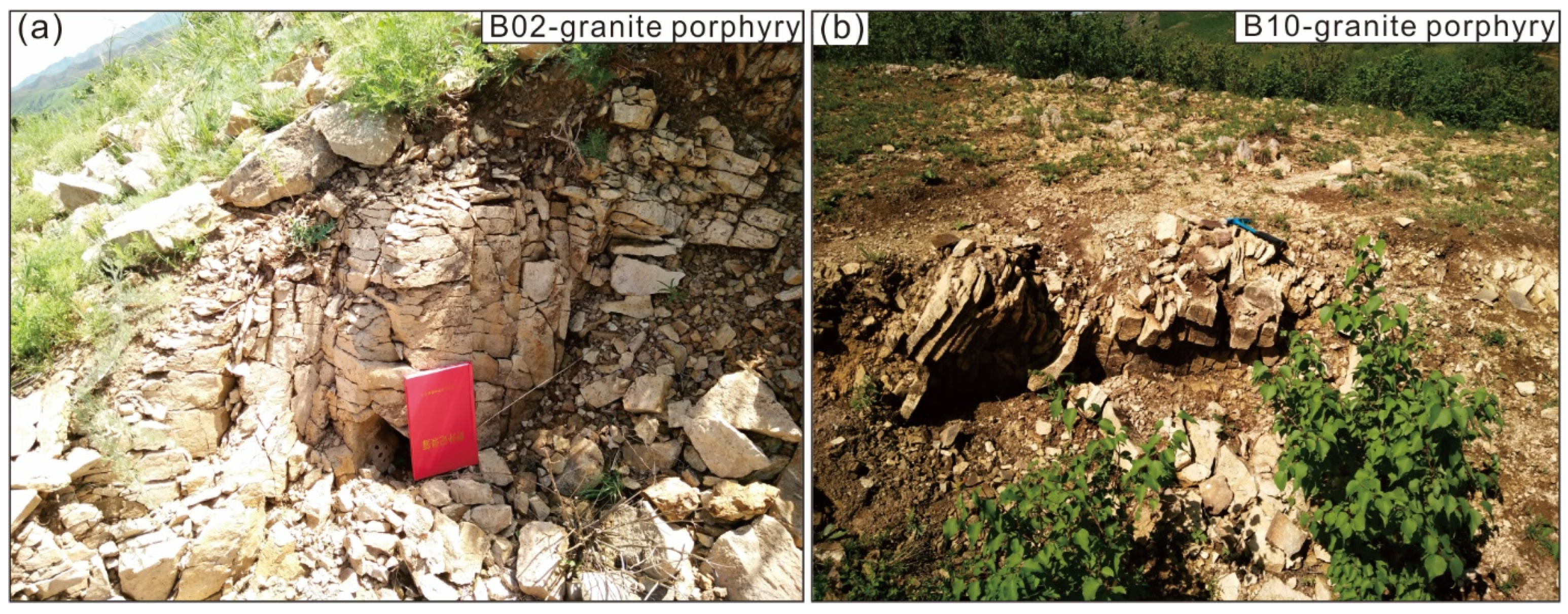
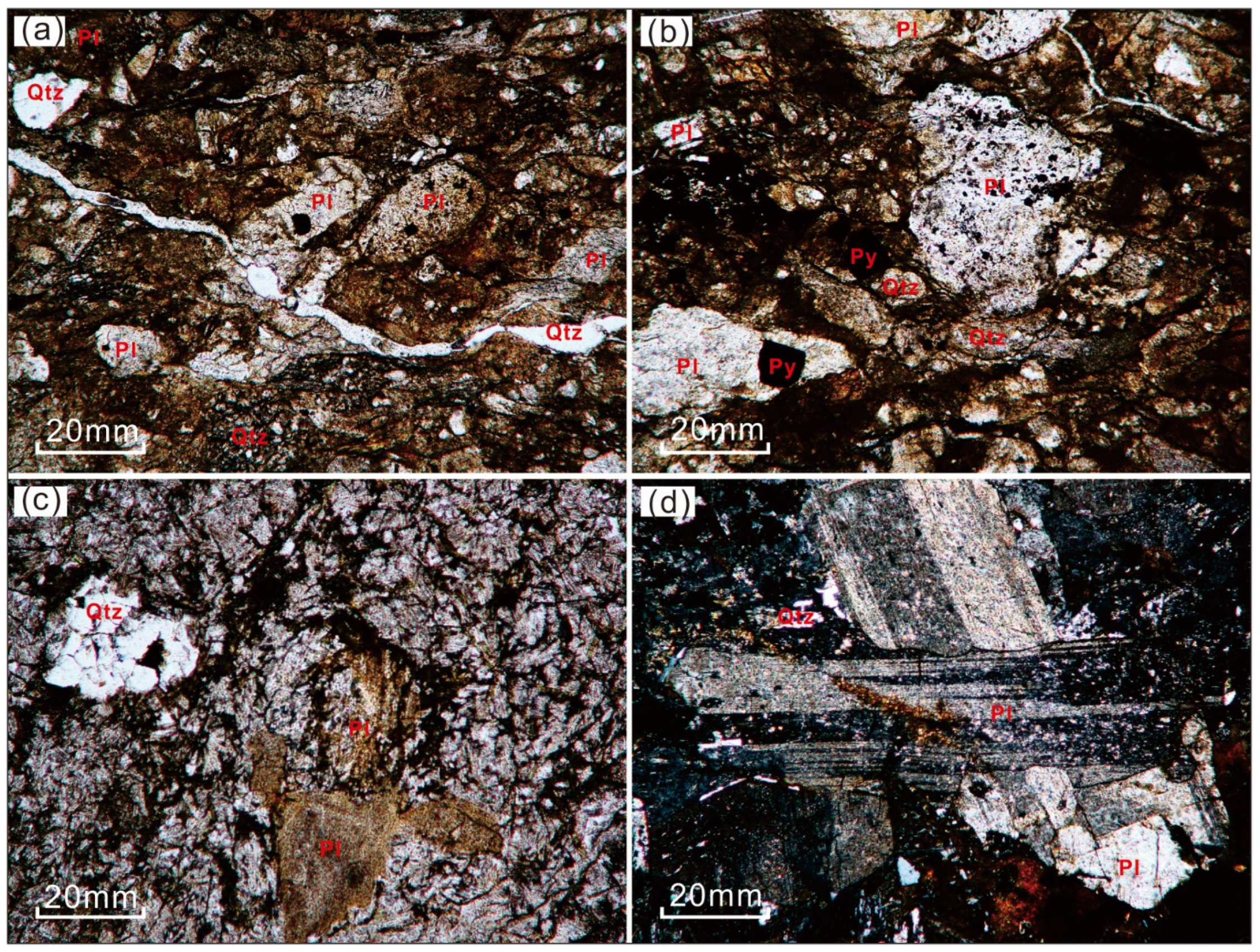

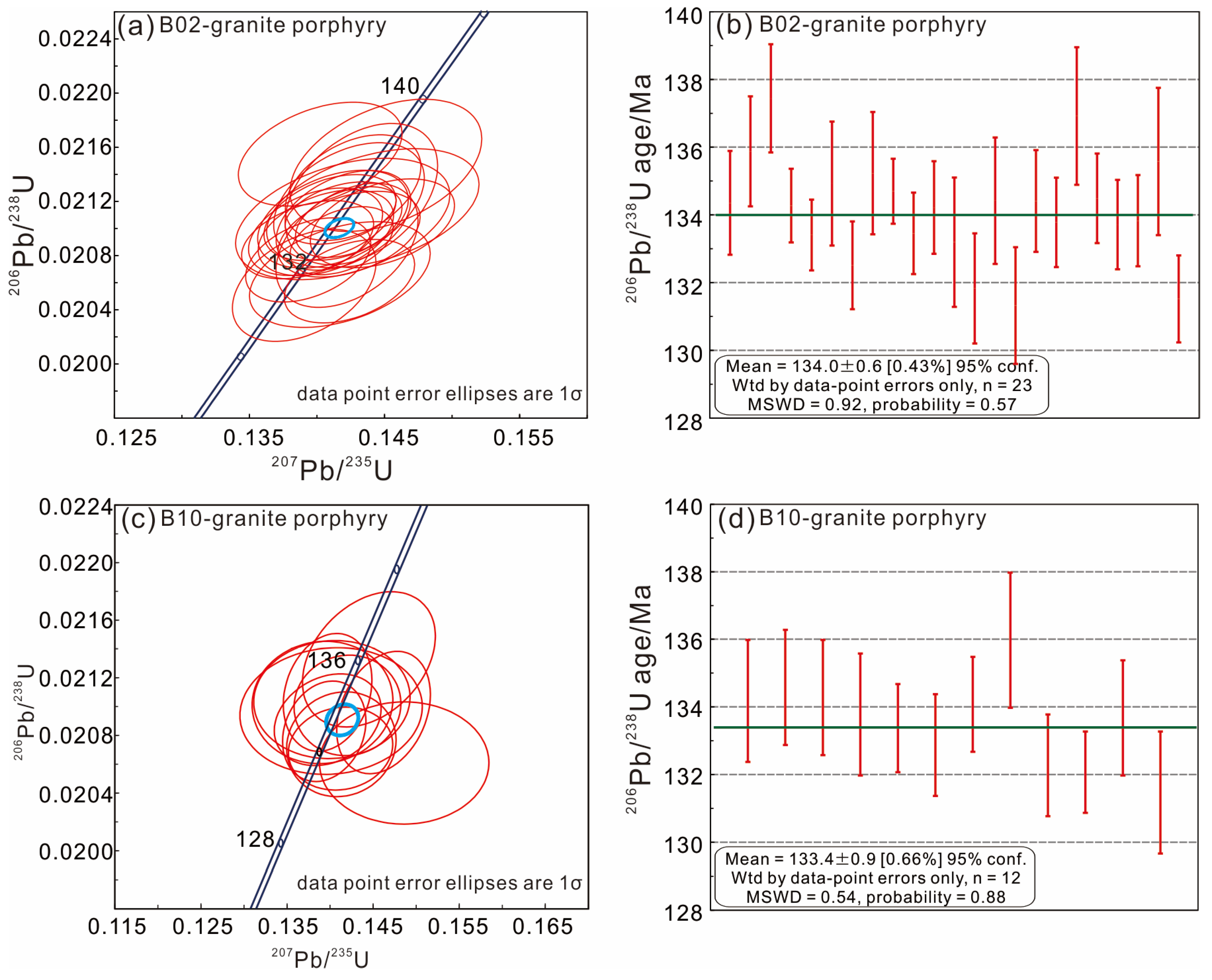
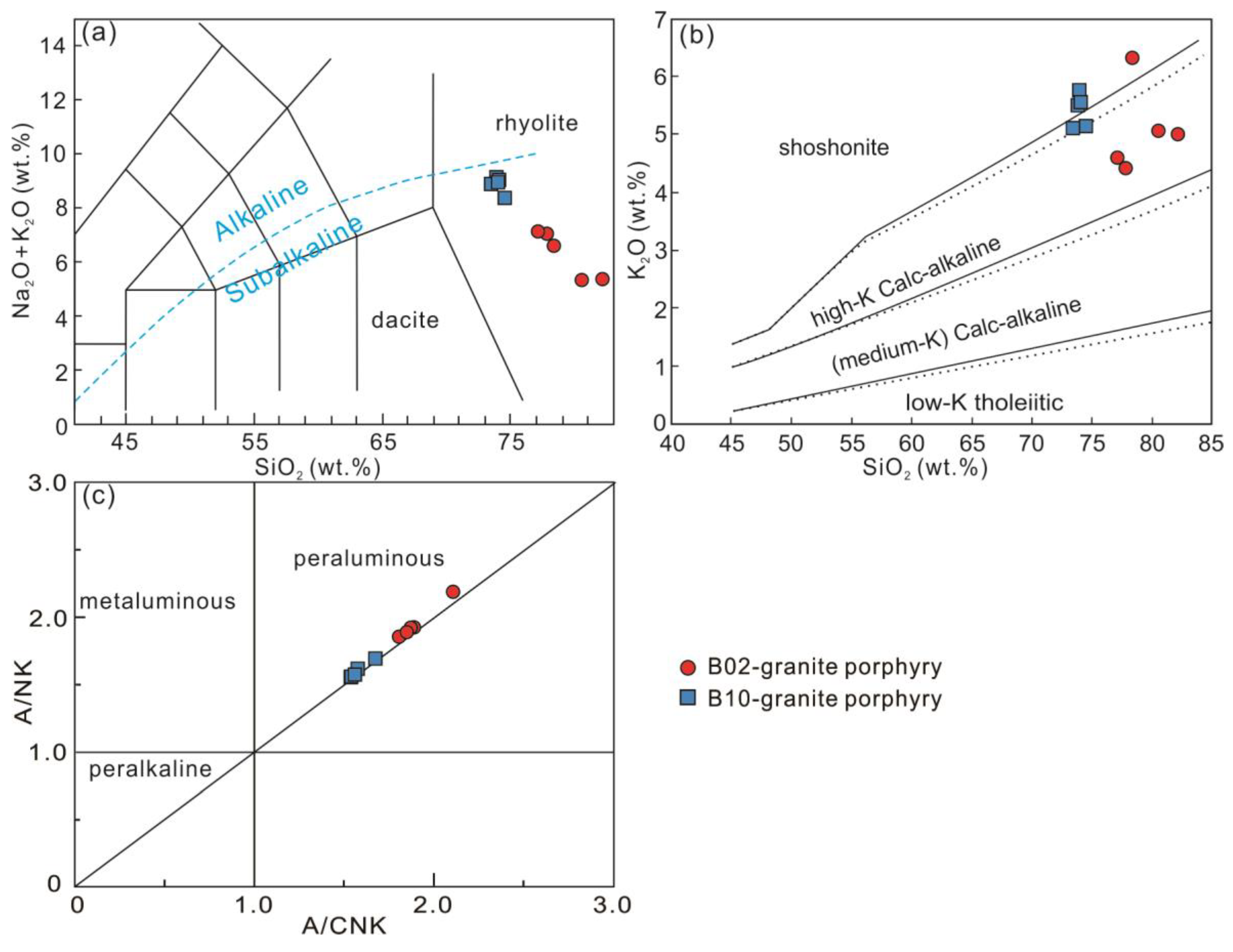
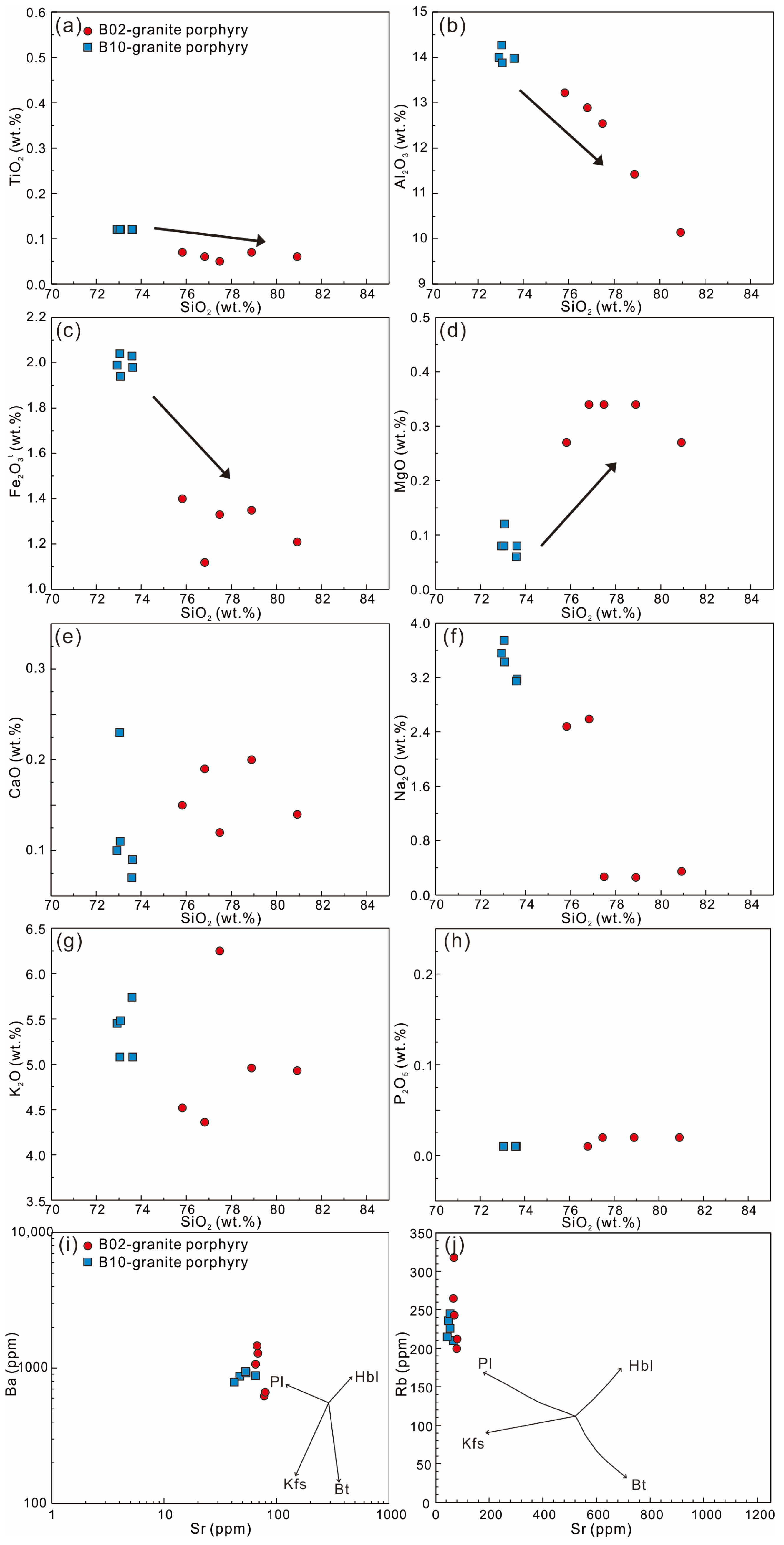

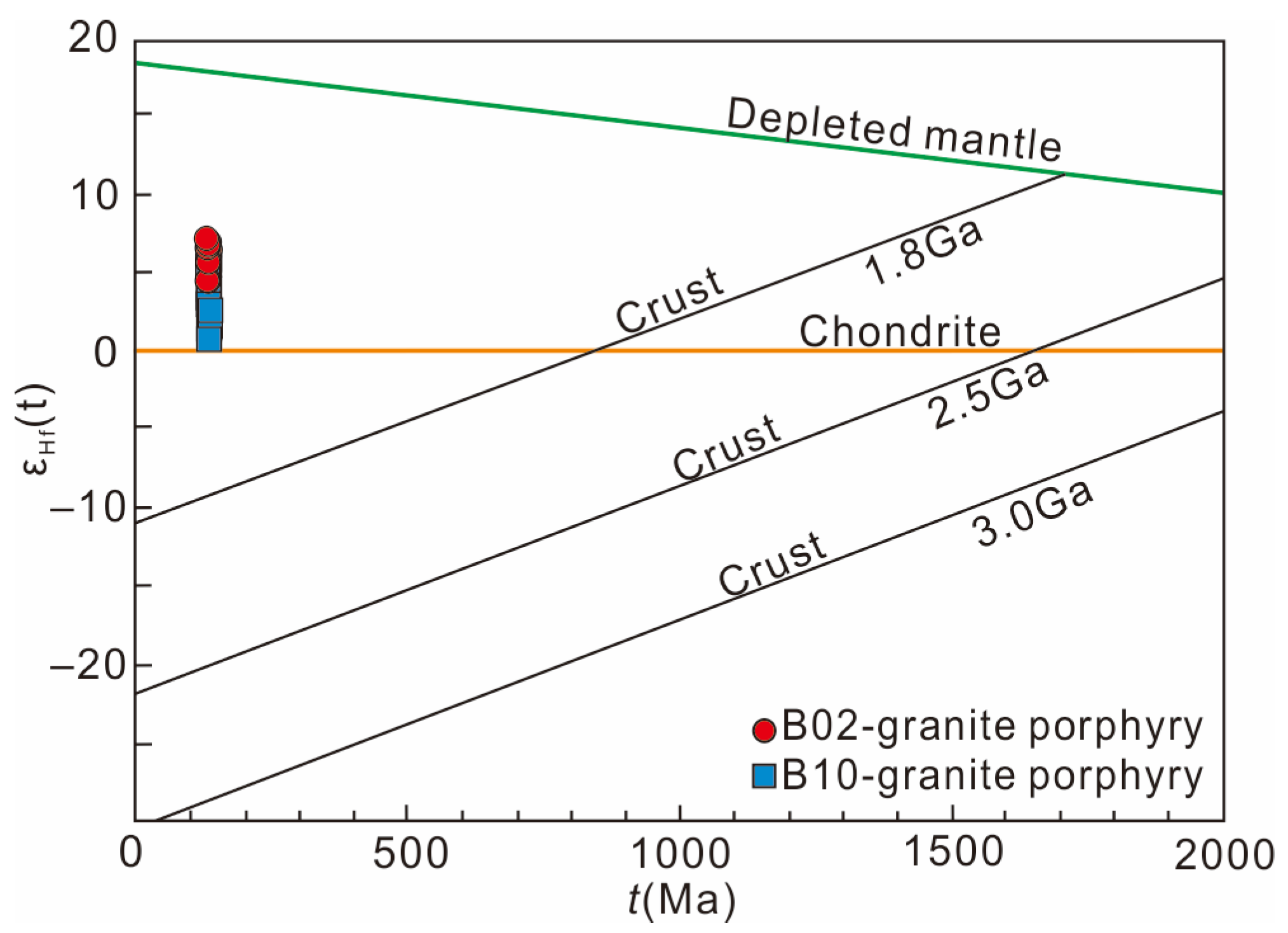
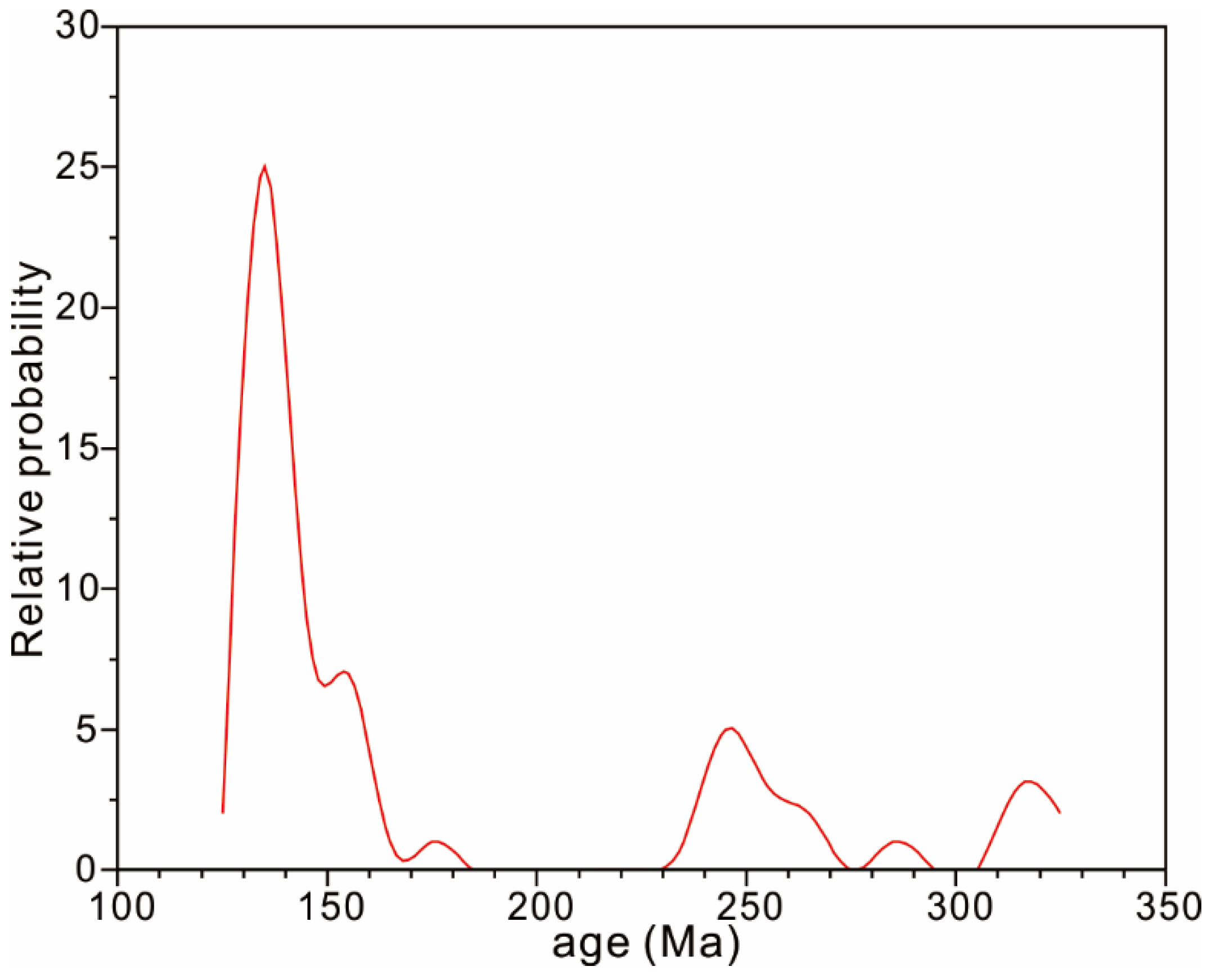
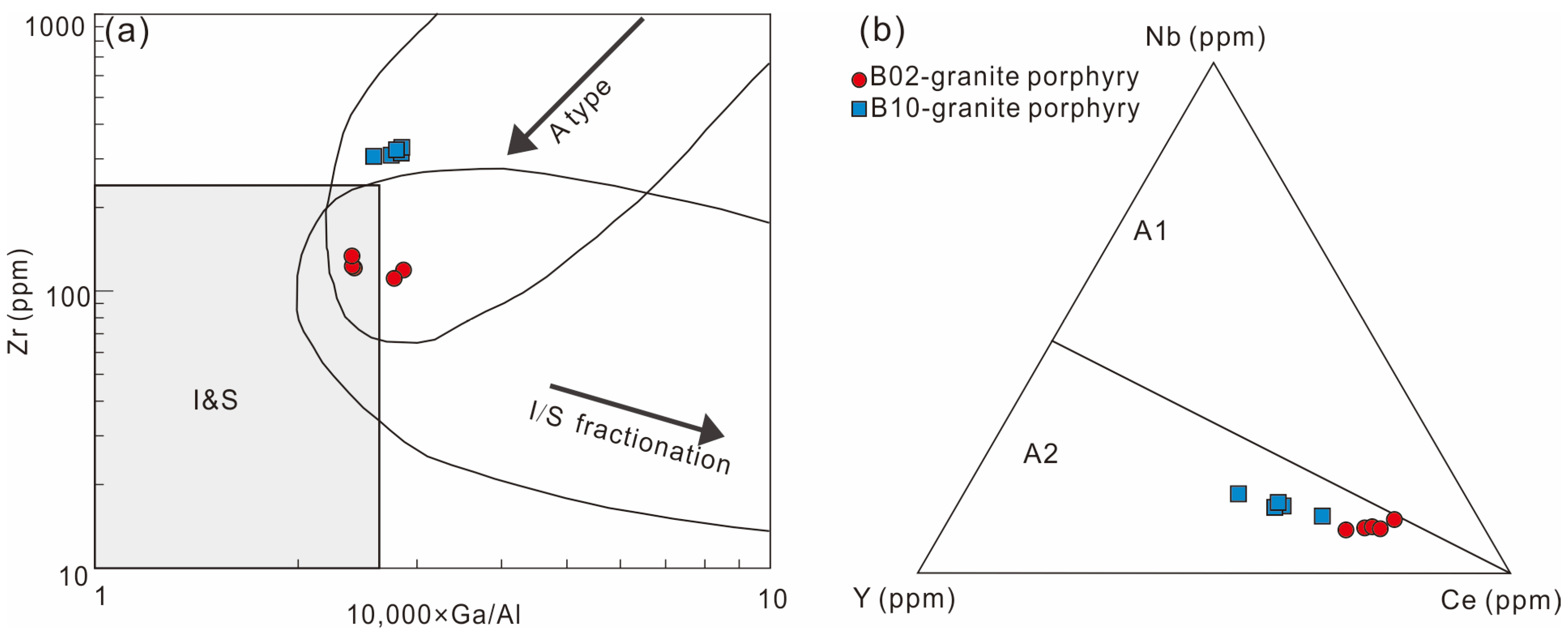
Disclaimer/Publisher’s Note: The statements, opinions and data contained in all publications are solely those of the individual author(s) and contributor(s) and not of MDPI and/or the editor(s). MDPI and/or the editor(s) disclaim responsibility for any injury to people or property resulting from any ideas, methods, instructions or products referred to in the content. |
© 2024 by the authors. Licensee MDPI, Basel, Switzerland. This article is an open access article distributed under the terms and conditions of the Creative Commons Attribution (CC BY) license (https://creativecommons.org/licenses/by/4.0/).
Share and Cite
Li, M.; Yu, H.; Tian, Y.; Yue, H.; He, Y.; Yu, Y.; Sun, Z. Genesis and Tectonic Implications of Early Cretaceous Granites in the Haobugao Area, Southern Great Xing’an Range: Insights from Zircon U–Pb Geochronology, Hf Isotopic Composition, and Petrochemistry. Minerals 2024, 14, 1139. https://doi.org/10.3390/min14111139
Li M, Yu H, Tian Y, Yue H, He Y, Yu Y, Sun Z. Genesis and Tectonic Implications of Early Cretaceous Granites in the Haobugao Area, Southern Great Xing’an Range: Insights from Zircon U–Pb Geochronology, Hf Isotopic Composition, and Petrochemistry. Minerals. 2024; 14(11):1139. https://doi.org/10.3390/min14111139
Chicago/Turabian StyleLi, Mengling, Henan Yu, Yi Tian, Haixin Yue, Yanping He, Yingbo Yu, and Zhenjun Sun. 2024. "Genesis and Tectonic Implications of Early Cretaceous Granites in the Haobugao Area, Southern Great Xing’an Range: Insights from Zircon U–Pb Geochronology, Hf Isotopic Composition, and Petrochemistry" Minerals 14, no. 11: 1139. https://doi.org/10.3390/min14111139
APA StyleLi, M., Yu, H., Tian, Y., Yue, H., He, Y., Yu, Y., & Sun, Z. (2024). Genesis and Tectonic Implications of Early Cretaceous Granites in the Haobugao Area, Southern Great Xing’an Range: Insights from Zircon U–Pb Geochronology, Hf Isotopic Composition, and Petrochemistry. Minerals, 14(11), 1139. https://doi.org/10.3390/min14111139





